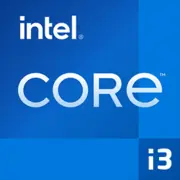Intel Core i3-1215U

Intel Core i3-1215U: a balance between performance and battery life for modern ultrabooks
March 2025
Architecture and manufacturing process: a hybrid approach for efficiency
The Intel Core i3-1215U processor, released as part of the Alder Lake lineup, has become one of the key solutions for budget ultrabooks and entry-level laptops. Its architecture is based on a hybrid scheme combining performance (P-cores) and efficient (E-cores) cores:
- 6 cores (2 P-cores + 4 E-cores) and 8 threads (P-cores support Hyper-Threading).
- P-cores operate at a base frequency of 1.2 GHz with turbo boost up to 4.4 GHz, while E-cores go up to 3.3 GHz.
- 10 MB of L3 cache provides quick data access for multitasking.
The Intel 7 process technology (previously known as 10nm Enhanced SuperFin) reduces power consumption and improves transistor density. The integrated graphics, Intel UHD Graphics for the 12th generation (64 EU, frequency up to 1.1 GHz), supports 4K displays and AV1 decoding, which is relevant for streaming.
Power consumption and TDP: 15W for thin devices
The processor's TDP is 15W, which is typical for ultrabooks. However, laptop manufacturers can adjust this parameter (for instance, increasing it to 25W in "Turbo" mode), which affects performance and heating.
- In standard scenarios (browser work, office tasks), the chip consumes 5-8W, prolonging battery life.
- Under load (video rendering, gaming), power consumption can reach 25W, but the cooling systems in thin chassis often struggle to maintain such levels over extended periods.
Performance: from office use to light gaming
Geekbench 6 showcases the strengths of the i3-1215U in single-thread tasks:
- 1842 points (Single-Core) — a level close to top processors from previous years (e.g., Intel Core i7-1165G7).
- 4817 points (Multi-Core) — a modest result due to the limited number of P-cores, but sufficient for basic multitasking.
Real-world scenarios:
- Office and study: simultaneous use of 20+ tabs in Chrome, Word documents, and Zoom — without lags.
- Multimedia: 4K video in VLC or YouTube plays smoothly, editing in DaVinci Resolve is possible but with limitations (videos up to 1080p).
- Gaming: in Dota 2 or CS:GO at low settings and 720p resolution — 30-45 FPS. For Fortnite, resolution needs to be dropped to 480p.
Turbo mode operates effectively in short bursts (e.g., opening heavy applications), but under prolonged load, P-core frequencies drop to 2.8-3.2 GHz due to overheating.
Use cases: who is the i3-1215U suitable for?
- Students and office workers — for working with documents, online courses, and video calls.
- Mobility-focused users — lightweight laptops weighing from 1.2 kg with battery life of 8-10 hours.
- Budget buyers — devices based on this CPU range from $450 to $700 (e.g., Acer Swift 3 or Lenovo IdeaPad 5).
Not suitable for:
- Gamers — the integrated graphics are insufficient for modern AAA titles.
- Video editors and engineers — 6 cores are insufficient for 4K rendering.
Battery life: up to 10 hours in power-saving mode
With a battery capacity of 50-60 Wh, laptops with the i3-1215U demonstrate:
- 8-10 hours when working with text and surfing (brightness set to 50%, Wi-Fi active).
- 4-5 hours when watching YouTube or on Zoom.
Power-saving technologies:
- Intel Dynamic Tuning 3.0 — adaptively adjusts power according to load.
- AV1 decoding — reduces power consumption during streaming.
Tip: disable Turbo Boost in Windows settings to improve battery life by 15-20%.
Comparison with competitors: AMD, Apple, and past generations
- AMD Ryzen 5 7520U (Zen 2, 4 cores/8 threads): weaker in single-thread tasks (~1600 in Geekbench 6), but better in multi-threaded performance (5000+ points). Similar price.
- Apple M1 (2020): surpasses the i3-1215U in energy efficiency and multitasking, but is limited to macOS and is more expensive ($700+).
- Intel Core i5-1135G7 (2020): lags in single-core performance (~1400 points) and does not support DDR5.
Pros and Cons
Strengths:
- High single-thread performance for its price.
- Support for DDR5-4800 and PCIe 4.0 (SSD up to 3.5 GB/s).
- Modern codecs (AV1, VP9).
Weaknesses:
- Only 2 P-cores — a bottleneck in heavy multi-threading.
- UHD graphics are weaker than AMD Radeon 660M and Apple M1 GPU.
- Limited TDP headroom in compact chassis.
Recommendations for choosing a laptop
1. Type of device: ultrabook or budget laptop.
2. Screen: IPS panel with 1080p resolution and anti-glare coating.
3. RAM: at least 8 GB DDR5 (better 16 GB).
4. Storage: 512 GB NVMe SSD (PCIe 4.0).
5. Ports: USB-C with Thunderbolt 4 support for connecting monitors.
Examples of models in 2025:
- HP Pavilion Aero 13 ($599): 13.3″ 2.5K, 16 GB DDR5, 512 GB SSD.
- ASUS Vivobook S14 ($649): OLED screen, M.2 SSD slot.
Final conclusion
The Intel Core i3-1215U is a solid choice for those looking for an affordable laptop with a performance cushion for the next 3-4 years. It can handle office tasks, light creative work, and streaming, but is not suitable for professional workloads. Its key advantages include energy efficiency, support for modern standards, and an accessible price. If your budget is limited to $500-700 and macOS is not a priority, this processor will be a reliable foundation for everyday tasks.
Basic
CPU Specifications
Memory Specifications
GPU Specifications
Miscellaneous
Benchmarks
Compared to Other CPU
Share in social media
Or Link To Us
<a href="https://cputronic.com/cpu/intel-core-i3-1215u" target="_blank">Intel Core i3-1215U</a>